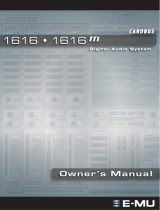
TABLE OF CONTENTS
CHAPTER 1 – INTRODUCTION................................................................................................................................3
1.1 WELCOME...........................................................................................................................................................3
1.2 PRODUCT OVERVIEW ..........................................................................................................................................4
1.3 CONCEPTS AND TERMINOLOGY ............................................................................................................................5
1.4 COMPONENTS .....................................................................................................................................................8
CHAPTER 2 – QUICKSTART GUIDE .......................................................................................................................9
CHAPTER 3 – CONTROLS AND INTERFACE.......................................................................................................10
3.1 COMPRESSOR SECTION.....................................................................................................................................10
3.2 TONE SECTION .................................................................................................................................................12
3.3 LINK SECTION ...................................................................................................................................................13
3.4 METER DISPLAY ................................................................................................................................................14
3.5 OUTPUT SECTION..............................................................................................................................................15
CHAPTER 4 – THE WAVESYSTEM .......................................................................................................................17
4.1 THE WAVESYSTEM TOOLBAR ............................................................................................................................17
Toolbar Functions .............................................................................................................................................17
4.2 PRESET HANDLING............................................................................................................................................17
Preset Types.....................................................................................................................................................17
Loading Presets and Setups ............................................................................................................................18
Saving Presets and Setups ..............................................................................................................................18
Deleting Presets ...............................................................................................................................................19
A/B Comparison and Copying ..........................................................................................................................19
4.3 INTERFACE CONTROLS ......................................................................................................................................19
Toggle Buttons..................................................................................................................................................19
Value Window Buttons......................................................................................................................................20
Sliders ...............................................................................................................................................................20
Hover Box .........................................................................................................................................................20
Multiple Selection of Controls ...........................................................................................................................20
TAB Functions ..................................................................................................................................................20
APPENDIX A – API 2500 CONTROLS ...................................................................................................................22
Waves API 2500 User Manual
- 2 -






















